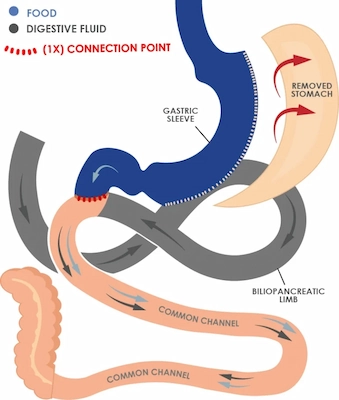SADI-S Surgery
Single Anastomosis Duodenal-Ileal Bypass with Sleeve Gastrectomy (SADI-S), is a progressive step in bariatric surgery for substantial and sustainable weight loss.
SADI-S Surgery
Single Anastomosis Duodenal-Ileal Bypass with Sleeve Gastrectomy (SADI-S), is a progressive step in bariatric surgery for substantial and sustainable weight loss.

Single Anastomosis Duodenal-Ileal Bypass with Gastric Sleeve (SADI-S) is an advanced bariatric procedure that is sometimes referred to as Stomach-Intestinal Pylorus Sparing (SIPS) surgery or Loop Duodenal Switch (LDS). It combines the benefits of sleeve gastrectomy with a partial bypass of the small intestine. This dual-action approach helps patients significantly reduce their body weight by both restricting food intake and limiting calorie absorption. The procedure also influences hormonal changes that aid in weight loss and the management of metabolic diseases.
Benefits of SADI-S
Resolution of Type 2 Diabetes
A large percentage of patients undergoing SADI-S experience a complete resolution or significant improvement of Type 2 diabetes, thanks to the procedure’s impact on the body’s metabolism and insulin sensitivity.
Improved Sleep Apnea
Many patients find their sleep apnea symptoms dramatically improve or disappear altogether post-SADI-S, reducing their reliance on CPAP machines and enhancing sleep quality.
Improved High Cholesterol and High Blood Pressure
Following the SADI-S procedure, a significant number of patients report improved cholesterol levels and blood pressure, contributing to a lower risk of cardiovascular diseases.

The SADI-S Procedure
Performed under general anesthesia, SADI-S is a laparoscopic weight loss procedure requiring a few tiny incisions. Initially, a sleeve gastrectomy is performed, removing approximately 80% of the stomach to create a smaller, tube-like stomach. The second part involves rerouting the small intestine to a loop about 300 cm from the ileocecal valve, significantly reducing the absorption of calories and nutrients.

Recovery After SADI-S
Recovery involves a phased approach to diet, starting with liquids and gradually introducing solid foods. Patients are encouraged to engage in light physical activity soon after surgery, with a gradual return to normal activities. Close monitoring and nutritional guidance are crucial to ensure optimal healing and adequate nutrient intake.
Who Is a Candidate SADI-S?
Ideal candidates for SADI-S are individuals with a body mass index (BMI) over 40 or those with a BMI over 35 who suffer from obesity-related health conditions such as sleep apnea, type 2 diabetes, or heart disease. A thorough evaluation by our weight loss surgeon will determine if SADI-S is the right procedure for you.
Invasiveness
Excess Weight Loss*
Rate of Weight Loss*
Average Procedure Time
Typical Hospital Stay*
Insurance Coverage Available*
Financing Available
Self Pay Cost
Gastric Balloon
Invasiveness
Excess Weight Loss*
Rate of Weight Loss*
Average Procedure Time
Typical Hospital Stay*
Insurance Coverage Available*
Financing Available
Self Pay Cost
Non-Invasive
20-40lbs
Slow
Less than 30 minutes
Out-patient
No
Yes
$5,995
ESG
Invasiveness
Excess Weight Loss*
Rate of Weight Loss*
Average Procedure Time
Typical Hospital Stay*
Insurance Coverage Available*
Financing Available
Self Pay Cost
Non-Invasive
40%
Slower
Less than 1 hour
Out-patient
Yes
Yes
$8,995
Gastric Banding
Invasiveness
Excess Weight Loss*
Rate of Weight Loss*
Average Procedure Time
Typical Hospital Stay*
Insurance Coverage Available*
Financing Available
Self Pay Cost
Minimal
40%
Slower
Less than 1 hour
Out-patient
Yes
Yes
$8,995
Gastric Sleeve
Invasiveness
Excess Weight Loss*
Rate of Weight Loss*
Average Procedure Time
Typical Hospital Stay*
Insurance Coverage Available*
Financing Available
Self Pay Cost
Minimal
40%
Slower
Less than 1 hour
Out-patient
Yes
Yes
$9,995
Gastric Bypass
Invasiveness
Excess Weight Loss*
Rate of Weight Loss*
Average Procedure Time
Typical Hospital Stay*
Insurance Coverage Available*
Financing Available
Self Pay Cost
Minimal
40%
Slower
Less than 2 hours
Out-patient
Yes
Yes
$11,995
DS/SADI-S
Invasiveness
Excess Weight Loss*
Rate of Weight Loss*
Average Procedure Time
Typical Hospital Stay*
Insurance Coverage Available*
Financing Available
Self Pay Cost
Minimal
40%
Slower
Less than 1 hour
Out-patient
Yes
Yes
*Call for Pricing
Frequently Asked Questions: SADI-S
What Is the Difference Between SADI-S and Other Bariatric Procedures?
SADI-S, also known as Stomach-Intestinal Pylorus Sparing (SIPS) surgery or Loop Duodenal Switch (LDS), uniquely combines the benefits of sleeve gastrectomy with a simplified bypass procedure, offering both restriction and malabsorption benefits with potentially fewer complications than traditional duodenal switch surgery.
Single Anastomosis Duodenal-Ileal Bypass with Sleeve Gastrectomy and the Roux-en-Y Gastric Bypass are both effective surgical weight loss procedures, but they differ in their approach and specific mechanisms of action. The Gastric Bypass involves the creation of a smaller stomach pouch and rerouting the small intestine to this pouch, which limits food intake and reduces the hunger producing hormones. This procedure is recognized for its long-term effectiveness in weight loss and the management of obesity -related health conditions.
SADI-S procedure combines a Sleeve Gastrectomy, where a significant portion of the stomach is removed to reduce its size, with a bypass of a part of the small intestine (similar to but more extensive than the Roux-en-Y Gastric Bypass), which further aids in weight loss by decreasing calorie absorption. Unlike the Roux-en-Y Gastric Bypass or Duodenal Switch, SADI-S involves only one intestinal anastomosis (connection), potentially offering a simpler surgical approach.
Is SADI-S Surgery Safe?
Yes, SADI-S/SIPS/LDS is considered a safe and highly effective weight loss surgery with lower perioperative risk., As with any surgical procedure, SADI-S carries risks, including nutrient deficiencies, acid reflux, and changes in bowel habits. Our team provides comprehensive care and guidance to minimize these risks.
Is SADI-S Covered by Insurance?
Whether SADI-S is covered by insurance largely depends on the specifics of your insurance policy and whether it includes bariatric coverage. Typically, if your insurance plan offers coverage for bariatric surgery, SADI-S may be included. However, it’s important to remember that every insurance policy is unique, with varying levels of coverage, prerequisites for surgery, and specific procedures covered. To determine if SADI-S is covered under your policy, it’s advisable to directly contact your insurance provider for the most accurate and personalized information. They can provide details on coverage eligibility, any necessary pre-surgery requirements, and guidance on the claims process. We are happy to assist you with checking your benefits with our Free Insurance Check.
What Is the Cost of SADI-S if It’s Not Covered Under My Insurance Policy?
To ensure our patients have access to this life-changing surgery, we offer competitive and affordable self-pay pricing, as well as a variety of financing options to suit different budgets. We understand that investing in your health is a significant decision, and we aim to make the process as accessible as possible. For detailed information on pricing and what’s included in the cost of surgery, review our self-pay packages. Our team is dedicated to providing you with the support and guidance you need to make an informed decision about your health and well-being.
Is SADI-S an Outpatient Procedure?
The SADI-S (Single Anastomosis Duodenal-Ileal Bypass with Sleeve Gastrectomy) procedure is not performed as an outpatient surgery, given its complexity and the level of postoperative care required. Patients undergoing SADI-S at a facility like Crestwood Medical Center or Huntsville Hospital typically stay in the hospital for one night to ensure they are recovering well and to manage any immediate postoperative needs such as pain control, hydration, and the initiation of post-surgery diet protocols.
Step into Wellness: Your Path to a
Lighter, Brighter Future Starts Now
Connect with Alabama Surgical Associates to take a proactive step towards your weight loss
goals. With our expert team and comprehensive approach, you’ll find the guidance and
support you need to achieve lasting results and improved well-being.
Dr. Darrell Doucette has either authored or reviewed and approved this content.
Page Updated:
1 Surgery for Obesity and Related Diseases. Single anastomosis duodeno-ileal bypass with sleeve gastrectomy (SADI-S): short-term outcomes from a prospective cohort study. Available: https://www.soard.org/article/S1550-7289(20)30545-1/fulltext. Accessed February 8, 2024.
2 Langenbecks Archives of Surgery. Single anastomosis duodenal-ileal bypass with sleeve gastrectomy (SADI-S): experience from a high-bariatric volume center. Available: https://www.ncbi.nlm.nih.gov/pmc/articles/PMC9399205/. Accessed February 8, 2024.
3 Obesity Surgery. Evaluation of Metabolic Outcomes Following SADI-S: a Systematic Review and Meta-analysis. Available: https://link.springer.com/article/10.1007/s11695-021-05824-w. Accessed February 8, 2024.